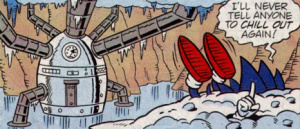Arctic Zone
From Sonic Retro
The Arctic Zone is a location that appears in issue #26 of Archie Comics' Sonic the Hedgehog comic series. An artificial arctic inside a cave, it was built by a stranded group of arctic Mobians.
Contents
Overview
Description
The Arctic Zone is an artificial cold climate deep inside a cave near Robotropolis. Preceded by an artificially heated area of the cave with a sign pointing to its direction, the Arctic Zone opens up as an alcove with piles of snow, a frozen floor and icicles hanging from the ceiling. The cave's temperature control device, responsible for both the cave's warmth and the Zone's frigidity, is also located there.
History
Having initially just traveled south from the Northern Tundra to visit friends and family, Guntiver the Arctic Wolf, Augustus the Polar Bear, Sealia Seal, Erma Ermine and Flip Penguin were forced to seek refuge in a cave after Dr. Robotnik began his conquest of the Kingdom of Acorn. While the deep cave's walls protected them from being detected by Robotnik's sensors[1], the arctic Mobians still needed a cold environment in order to survive. Therefore the Mobians built a system for controlling the cave's temperature using machinery that Robotnik had discarded, which they acquired by sneaking out at night.
Sonic the Hedgehog and the Knothole Freedom Fighters once stumbled upon the cave while seeking shelter from Robotnik's Weather Annihilator, receiving a warm welcome from the arctic Mobians. After helping the Freedom Fighters train to withstand cold environments for a week by using the Arctic Zone, the arctic Mobians fought alongside them to take down the Weather Annihilator.
After their eventual triumph over Robotnik, the Mobians left the cave and its Arctic Zone behind in order to return to their home in the north.
